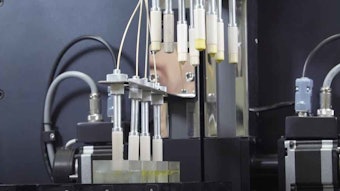
Solubility is a hurdle when it comes to topically delivering agents to heal wounds. A new study of drug-impregnated, pressurized gas-expanded (PGX) and liquid-processed alginate hydrogel scaffolds, however, developed by biotech firm Ceapro Inc., were recently shown to accelerate wound healing in burns.
The study, conducted with Canadian-based McMaster University, will appear in an upcoming issue of Acta Biomaterialia. In the article abstract, the authors described the significance of their work.
"The inherent incompatibility between conventional hydrogels and many poorly water-soluble drugs of relevance in wound healing remains a challenge. Herein, we leveraged supercritical fluids-based strategies to both process and subsequently impregnate alginate, followed by post-cross-linking to form a hydrogel, to create a very high surface area alginate hydrogel scaffold loaded with high hydrophobic drug contents ... without the need for any pore-forming additives."
According to Ceapro, the high surface area of the PGX-processed alginate scaffold facilitated a > 8.0% wt loading of ibuprofen into the scaffold and controlled the in vitro ibuprofen release over 12-24 hours. In vivo burn wound healing assays demonstrated statistically significant accelerated healing with ibuprofen-loaded PGX-alginate/calcium scaffolds relative to both hydrogel only and untreated controls. This confirmed the technology's capabilities to deliver ibuprofen, to suppress inflammation, and to maintain wound hydration and facilitate continuous calcium release to the wound.
The technology can be used to process biopolymers into high-value, fine-structured, open-porous polymer structures and novel biocomposites.
“These positive results from this research project demonstrated that PGX-alginate can provide a unique set of properties useful for accelerating the wound healing process and represents a scalable method of producing medicated macroporous hydrogel-based wound dressings with improved performance over conventional dressings,” stated Todd Hoare, Ph.D., professor at the department of chemical engineering at McMaster University.
“We anticipate this strategy to be highly adaptable to other water-soluble polymers and scCO2-soluble drugs, making it possible to produce other types of drug-impregnated scaffolds for wound healing or other applications in which the delivery of a hydrophobic drug from a hydrogel is functionally beneficial," Hoare added.
Ceapro’s PGX technology can be used to process biopolymers into high-value, fine-structured, open-porous polymer structures and novel biocomposites. According to the company, it is ideally suited for processing challenging high-molecular-weight, water-soluble biopolymers. It has the ability to make ultra-light, highly porous polymer structures on a continuous basis.










